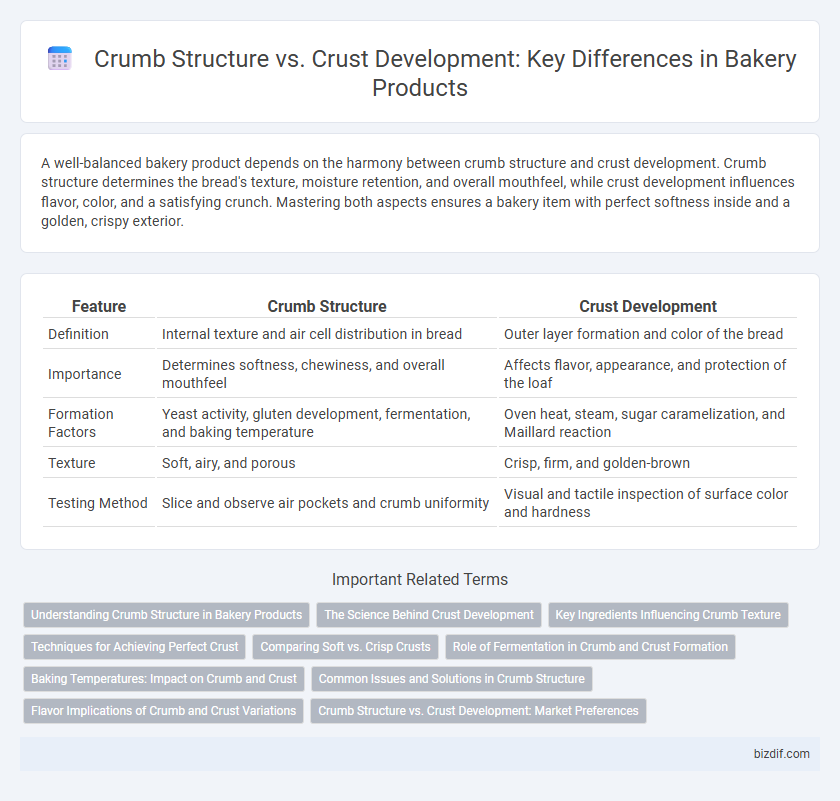A well-balanced bakery product depends on the harmony between crumb structure and crust development. Crumb structure determines the bread's texture, moisture retention, and overall mouthfeel, while crust development influences flavor, color, and a satisfying crunch. Mastering both aspects ensures a bakery item with perfect softness inside and a golden, crispy exterior.
Table of Comparison
| Feature | Crumb Structure | Crust Development |
|---|---|---|
| Definition | Internal texture and air cell distribution in bread | Outer layer formation and color of the bread |
| Importance | Determines softness, chewiness, and overall mouthfeel | Affects flavor, appearance, and protection of the loaf |
| Formation Factors | Yeast activity, gluten development, fermentation, and baking temperature | Oven heat, steam, sugar caramelization, and Maillard reaction |
| Texture | Soft, airy, and porous | Crisp, firm, and golden-brown |
| Testing Method | Slice and observe air pockets and crumb uniformity | Visual and tactile inspection of surface color and hardness |
Understanding Crumb Structure in Bakery Products
Understanding crumb structure in bakery products is essential for achieving the desired texture and mouthfeel. Crumb structure depends on factors such as gluten formation, fermentation time, and baking temperature, which influence the size and distribution of air pockets within the dough. Proper control of these variables results in a moist, tender crumb that complements the crust development and overall quality of baked goods.
The Science Behind Crust Development
Crust development in baking relies on the Maillard reaction, where sugars and amino acids interact under heat to create a golden, flavorful exterior. Moisture loss during baking also influences crust texture, leading to a crispy and firm outer layer. This process contrasts with crumb structure formation, which depends on gluten network expansion and gas retention for softness and aeration inside the bread.
Key Ingredients Influencing Crumb Texture
Key ingredients such as flour protein content, hydration levels, and fat types significantly influence crumb texture in baking. High-protein flours promote a tighter crumb structure by developing stronger gluten networks, while increased hydration results in a more open, airy crumb. Fats, including butter or oil, tenderize the crumb by shortening gluten strands, enhancing softness and keeping the bread moist.
Techniques for Achieving Perfect Crust
Mastering crust development involves controlling oven temperature and steam levels to achieve a golden, crispy exterior while preserving a tender crumb structure. Techniques such as scoring the dough before baking promote even expansion and prevent crust cracking. Utilizing high hydration doughs and incorporating a preheated baking stone or steel also enhance crust crispness through efficient heat transfer and moisture retention.
Comparing Soft vs. Crisp Crusts
Soft crusts feature fine, tender crumb structures due to higher moisture retention and limited caramelization during baking, resulting in a pliable texture ideal for sandwich breads. Crisp crusts develop through higher baking temperatures and evaporative moisture loss, creating a thicker, more rigid exterior with a pronounced Maillard reaction that contrasts with an open, airy crumb. The balance between crumb structure and crust development directly influences mouthfeel and shelf life, with soft crusts favoring chewiness and crisp crusts providing a satisfying crunch.
Role of Fermentation in Crumb and Crust Formation
Fermentation plays a crucial role in developing both crumb structure and crust in bakery products by influencing gas production and dough acidity. The carbon dioxide generated during fermentation creates air pockets, resulting in an open and airy crumb, while organic acids contribute to crust browning through Maillard reactions. Proper fermentation timing and temperature optimize enzymatic activity, enhancing texture, flavor, and crust color in bread.
Baking Temperatures: Impact on Crumb and Crust
Baking temperatures play a critical role in crumb structure and crust development, with higher temperatures promoting a thicker, darker crust due to rapid Maillard reactions and caramelization. Lower temperatures result in a softer crust and a more open, tender crumb, as slower heat penetration allows for even gas expansion and moisture retention. Optimal temperature control balances crust crispness and crumb texture, enhancing overall bread quality in artisanal and commercial bakery production.
Common Issues and Solutions in Crumb Structure
Uneven crumb structure in baked goods often results from improper mixing, insufficient fermentation, or incorrect hydration levels. Addressing dense or gummy crumbs requires balancing yeast activity and ensuring proper dough proofing times to promote uniform gas retention. Adjusting ingredients like flour protein content and incorporating proper folding techniques can improve crumb softness and overall texture.
Flavor Implications of Crumb and Crust Variations
Crumb structure influences the moisture retention and mouthfeel of baked goods, directly affecting flavor perception by highlighting the tomato buttery or nutty notes in bread. Crust development, achieved through Maillard reactions and caramelization during baking, creates complex, aromatic compounds that enhance the overall taste experience with toasty, sweet, and savory flavors. Variations in crumb density and crust thickness work together to balance texture and flavor intensity, playing a crucial role in defining a bakery product's distinctive taste profile.
Crumb Structure vs. Crust Development: Market Preferences
Crumb structure and crust development significantly influence market preferences in the bakery industry, with consumers often favoring a balanced combination of a soft, airy crumb and a crisp, well-browned crust. Artisan breads with an open crumb and deeply caramelized crust tend to attract premium market segments, while softer crusts with fine, uniform crumbs appeal to mass-market consumers seeking convenience. Product positioning and marketing strategies frequently prioritize crumb and crust characteristics tailored to regional tastes, enhancing product differentiation and consumer satisfaction.
Crumb Structure vs Crust Development Infographic

 bizdif.com
bizdif.com